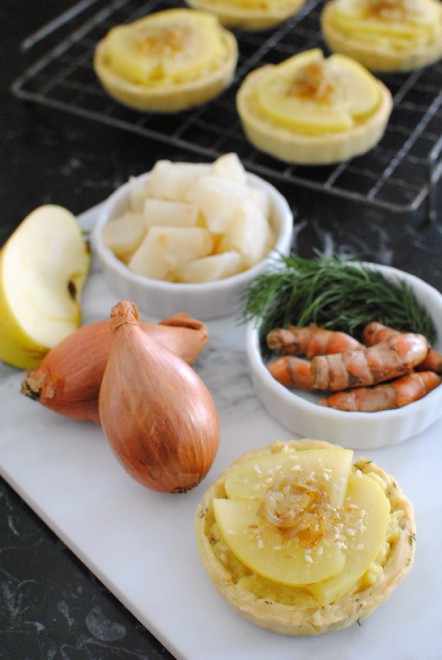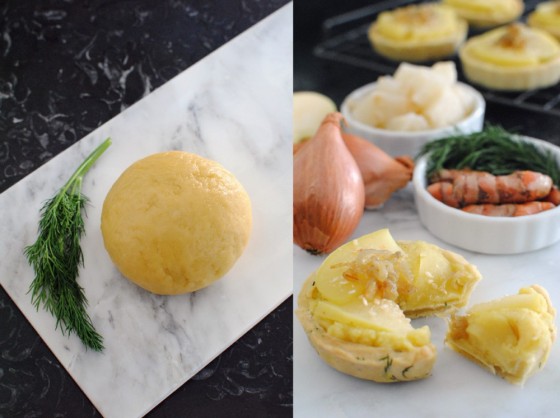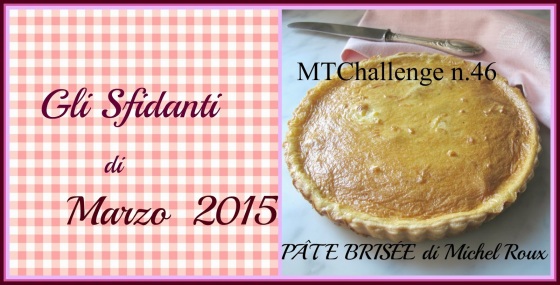For this month’s MTC Challenge Elisa challenges us with a basic cooking preparation, brisée pastry. At first I thought I could not participate because the guideline called for the use of Michel Roux’s recipe. Fortunately, after writing to MTC’s staff I was reassured that in cases of allergies and health problems we were allowed to use other ingredients to substitute the ones indicated in the given recipe, so I decided to try out my first vegan brisée. Unfortunately my enthusiasm, I guess spoiled by my my natural inclination to rush into things, did not help. Unfortunately the sneaky pastry came out under cooked, but apparently fine as it looked perfectly cooked on the top and bottom. Since I liked the recipe very much and have no time whatsoever to re-try it alltogether I just tested the dough once more (also working it less as suggested by Roux) to make sure it would cook thoroughly and write in the post the right baking temperature and time. Here the results to prove the recipe is good!
On saturday, during a round of food shopping tour in Milan with my friend Laura, I came across fresh turmeric for the first time in my life. With no clue what to use it for I just bought it and then decided to try it out for my recipe for this month’s MTC Challenge. Turmeric is a root coming from the same family as ginger, and is produced in China, Indonesia, Costa Rica. In Hawaii, where it is known as “holena”, it is the basis of most of the traditional remedies. In India it has been used for centuries in Ayurvedic medicine due to its preventive and therapeutic virtues, especially for its healing and anti-inflammatory proprieties. It is believed to help digestion, boost the immune system and detox the liver. Turmeric should be consummed along with black pepper, green tea or fats such as olive oil or butter to help its absorption. Its flavor is quite pungent and perhaps not to the like of all, so you can just replace it with half a teaspoon of saffron powder if you prefer sweeter tastes. For the cream I chose celeriac, which has an aromatic and slightly sweet taste. Celeriac has anti-inflammatory properties, can be useful in treating rheumatism, lung diseases, kidney stones (acting as a diuretic), liver failure and being rich in minerals is also recommended in cases of fatigue and demineralization. For the crust flavoring I chose dill, a herb very fresh in flavor that I particularlylove and like put anywhere in my food, from the rice dishes to crackers. Dill is an ally to our intestine, on which it plays an antispasmodic and carminative effect favoring the expulsion of gas from the stomach and intestines. Its diuretic and depurative help us to eliminate toxins and cellulite. I chose to garnish the pies with apple and shallots for their natural sweetness. Apple, rich in fiber, is a blessing for our health. Eating an apple a day helps fighting asthma and cleansing the body. Its consumption helps regulating bowel transit and provides us with vitamins and minerals while keeping slim. Shallots, like garlic and onion, possesses molecules that help regulating blood pressure, stimulating diuresis, reducing cholesterol, oxidation, inflammation and the aggregation of blood platelets.
Dill Pastry Crust
x 12 mini pies
250 g pastry flour
50 g extra virgin olive oil
1 teaspoon salt
1 egg
50 ml cold water
2 heaping tablespoons of dried dill
In a bowl mix the flour with the dill and add the egg beaten with oil and water.
Knead with your hands until you get a soft and homogeneous dough, do not overwork it the ingredients must be just well mixed.
Wrap in cling film and let stand 30′.
Roll out the dough to a thickness of about 2 mm and cut into disks which have a circumference of about 2 cm wider than that of your moulds.
Oil the molds and insert the disks of dough by pressing lightly on the bottom and the edges to give them a nice shape.
Prick the bottom of the dough with a fork, let chill the dough for 10′ in the fridge to prevent it from breaking while baking and then cover the entire surface with dried chickpeas.
Bake in preheated oven at 190° C for 5′, then remove the chickpeas and bake an additional 20′.
Let cool on a wire rack.
Cream of celeriac and turmeric
500 g boiled celeriac (about 470 g of raw celeriac)
2 g fresh turmeric
2 tablespoons gomasio
black pepper
For the garnish
half an apple
2 shallots
First grate the turmeric.
Use gloves because this root stains a lot (and pay attention to various bowls and plastic utensils, use glass or ceramic containers to avoid leaving unpleasant stains on porous material).
Peel the turmeric and grate.
In a measuring cup blend the celery root, turmeric, gomasio and pepper into a smooth cream.
Cut the apple into slices of about 2 mm, cut them in half and boil them in water for about 5′.
In a nonstick frying pan, heat 1 teaspoon of olive oil and saute the chopped shallots over medium-low heat until they become golden brown.
If the shallots dry out you can add some water, a bit at a time.
Fill the pastry shells with the celeriac and turmeric cream and garnish with sliced apples, a splash of gomasio and shallots.
MTC Challenge: Tortine al sedano rapa, curcuma, mela e cipolla con brisée all’aneto
Questo mese per l’MTC Challenge Elisa ci sfida con una preparazione base, la pasta brisée. All’inizio pensavo di non poter partecipare visto che la consegna imponeva l’uso della ricetta fornita nel regolamento. Fortunatamente dopo aver scritto allo staff MTC mi è stato detto che in casi di intolleranze, allergie e problemi di salute ci era concesso di usare altri ingredienti che non fossero quelli indicati dalla ricetta base, sicché ho deciso di lanciarmi nella mia prima brisée vegana. Purtroppo il mio entusiasmo, e la mia naturale predisposizione alla fretta, non mi è stato d’aiuto in quanto purtroppo l’infingarda brisè all’olio è venuta cotta sotto, cotta sopra e cruda all’interno. Ma visto che la ricetta mi è piaciuta (per problemi di tempo non ho nemmeno avuto modo di poterla rifare per partecipare in tempo al challenge ma ho testato a parte l’impasto brisée lavorandolo di meno come consigliato da Roux stesso e rivedendo i tempi di cottura) e non volevo rinunciare alla partecipazione alla sfida ecco qua che ve la propongo. Qua potete vedere la foto che dimostra la riuscita del secondo impasto.
Sabato, durante un giro di acquisti alimentari milanesi con la mia amica Laura ci siamo imbattute per la prima volta nella curcuma fresca. Come resistere al suo richiamo? La curcuma, radice appartenente alla stessa famiglia dello zenzero, è un vero toccasana. Alle Hawai, dove è chiamata “holena”, è la base di gran parte della medicina tradizionale. In India viene utilizzata da secoli nella medicina Ayurvedica per le sue virtù preventive e terapeutiche, soprattutto come cicatrizzante e antinfiammatorio, per aiutare la digestione, stimolare il sistema immunitario e disintossicare il fegato. La curcuma va assunta insieme a pepe nero, tè verde oppure grassi come olio d’oliva e burro per facilitarne l’assorbimento. Il suo sapore è pungente e forse non piace a tutti, potete benissimo sostituirla con mezzo cucchiaino di zafferano in polvere se preferite i gusti più dolci. Per la crema ho scelto il sedano rapa, dal gusto aromatico e leggermente dolce. Il sedano rapa ha proprietà antinfiammatorie, è utile contro reumatismi, per curare affezioni polmonari, calcoli renali (svolgendo un’azione diuretica), insufficienza epatica ed essendo ricca di sali minerali è consigliato il suo consumo in casi di stanchezza e demineralizzazione. Per la brisée ho scelto un’aromatizzazione all’aneto, erba dal sapore freschissimo che amo particolarmente e che metto ovunque, dal riso ai crackers. L’aneto è alleato dell’intestino, sul quale svolge un effetto antispasmodico e carminativo favorendo l’espulsione di gas da stomaco e intestino. Le sue proprietà diuretiche e depurative ci aiutano ad eliminare scorie e cellulite. Per guarnire ho scelto la dolcezza della mela e dello scalogno. La mela, ricca di fibre, è un vero toccasana per la salute. Il consumo di una mela al giorno aiuterebbe a contastare l’asma e depurare l’organismo. Il suo consumo aiuta a regolare transito intestinale e ci fornisce vitamine e sali minerali mantenendo al contempo la linea. Lo scalogno, come aglio e cipolla, possiede molecole che sono utili alla regolazione della pressione sanguigna, stimolano la diuresi, riducono l’aggregazione delle piastrine nel sangue, il colesterolo, ossidazioni e infiammazioni.
Pasta brisée all’aneto
x 12 tortine
250 g farina 00
50 g olio evo
1 cucchiaino di sale
1 uovo
50 ml acqua fredda
2 cucchiai colmi di aneto essiccato
Mischiate la farina setacciata in una ciotola con l’aneto e aggiungete l’uovo sbattuto con l’olio e l’acqua.
Impastate con le mani finché otterrete un impasto morbido e omogeneo, non lavorate troppo l’impasto o diventerà duro.
Avvolgete in pellicola e lasciate riposare 30′.
Stendete l’impasto ad uno spessore di circa 2 millimetri e tagliate dei dischi che abbiano una circonferenza di circa 2 cm in più di quella dei vostri stampini.
Oliate gli stampini e inserite i dischi di impasto premendoli leggermente sul fondo e i bordi per dar loro una bella forma omogenea.
Con i rebbi di una forchetta punzecchiate il fondo dell’impasto, mettete gli stampini 10′ in frigorifero per evitare che la pasta in cottura si rompa e poi ricoprite tutta la superficie con ceci secchi.
Cuocete in forno preriscaldato a 190° C per 5′, poi togliete i ceci e cuocete un ulteriore 20′.
Lasciate raffreddare su una gratella.
Crema di sedano rapa e curcuma
500 g sedano rapa bollito (circa 470 g a crudo)
2 g di curcuma fresca
2 cucchiai di gomasio
pepe nero
Per guarnire
mezza mela
2 scalogni
Per prima cosa grattuggiate la curcuma.
Munitevi di guanti poiché questa radice ha un alto potere colorante (e fate attenzione a varie ciotole e utensili di plastica, usate piuttosto contenitori in vetro o ceramica per evitare di lasciare spiacevoli macchie su materiale poroso).
Sbucciate la curcuma e grattuggiatela.
In un bicchiere graduato frullate il sedano rapa, la curcuma, il gomasio e il pepe finché ptterrete una crema omogenea e senza grumi.
Tagliate la mela in fettine spese circa 2 millimetri, tagliatele a metà e fatele cuocere in acqua bollente per circa 5′.
In un padellino antiaderente scaldate 1 cucchiaino di olio evo e fate soffriggere a fuoco medio-basso lo scalogno tritato fine finché non assume un colore dorato.
Se vedete che lo scalogno asciuga aggiungetevi dell’acqua, un po’ alla volta.
Riempite le basi delle tortine con la crema di sedano rapa e guarnite con le mele, una spruzzata di gomasio e lo scalogno.
Con questa ricetta partecipo all’MTChallenge di Marzo 2015



